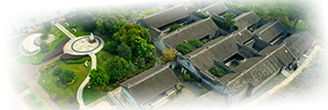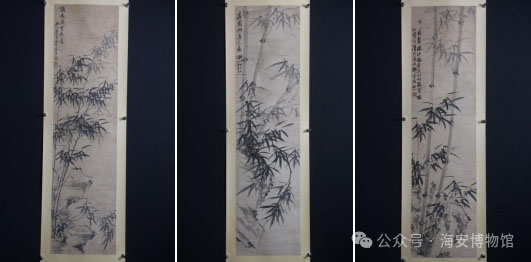Collection
CONTACT US
Tel:
Fax:
Website:www.jshamuseum.com
Add:58-8 Ninghai North Road, Hai'an City, Nantong City

Fax:

Website:www.jshamuseum.com
Add:58-8 Ninghai North Road, Hai'an City, Nantong City
| Li Rongzeng, Mozhu Ping |
| Hits:2332 Date:2025-08-04 |
[Historical Era]: Qing Dynasty [Collection Size]: 138 cm in length, 36.5 cm in width 【 Explanation 】: 1. Imitation and Possible Meanings by Li Rongzeng, a scholar of cultivating immortals Seal: Li Rongzeng's seal (in white script) Ren Shen seventy-two (in white script) 2: The meaning of the rain in Qiyuan is to cultivate immortals in the winter of Renshen Seal: Li Rong once stamped (white script) and painted with dried air (red script) 3: (Book window abuse) I have a fondness for Bi Langqi and sincerely endure the cold of the year. (Below is my explanation) Medical customs, clear standards, and carefree demeanor, sweeping the clouds and cultivating immortals Seal: Li Rongzeng Seal (in white script) 4: The first pole (rain and dew) in the Cuijie Bilanggan Danfeng Forest, Ennong Panshi Gutuo Long Chang Protects and Protects Peace, Renshen November 2-5, Gengxian Writing Seal: Li Rongzeng (seal) Ren Shen seventy-two (white text) five: * * Zhong Ji painting method Geng Xian Li Rong seal: Rongzeng private seal (white text) The second seal is blurry and unfamiliar. Chinese painting combines trees, bamboo, and stone in a freehand ink style, which is used to express the thoughts and feelings of literati, thanks to Su Shi and Wen Tong. Su Shi said in his poem "Praise and Citation of Paintable Bamboo, Wood, and Stone": "Bamboo is cold yet beautiful, wood is barren yet long-lived, and stone is ugly yet elegant. They are the friends of the three benefits. Painters use these three objects to express literati's integrity, grace, and personal ideals, in pursuit of self appreciation and freshness. Throughout history, painters have practiced Su Shi's literary spirit and created with his "best partner". However, Su Shi believed that a good bamboo and stone painting should be "born like this, died like this, twisted like a fist and withered like this, with lush and varied roots, stems, nodes, leaves, teeth, horns, veins, and threads, all in their own place. It is in line with the will of heaven and dislikes human will. A good work of bamboo should have various shapes and shapes that conform to the natural growth laws, imbuing bamboo with human emotions, expressing inner aspirations, and full of literary elegance. During the Qing Dynasty, the creative style based on bamboo and stone themes did not diminish. In the early Qing Dynasty, Zheng Banqiao's paintings of bamboo were the most famous, depicting the elegance of bamboo and the toughness of stone, vividly displayed on paper. Zheng Banqiao's bamboo also opened up the market and expanded his popularity, making new contributions to the development of Chinese literati painting. Since then, countless literati and painters have followed in the footsteps of the ancients, using Zheng Banqiao as a reference to initiate the trend of bamboo painting in the Qing Dynasty. This is the painting "Ink Bamboo Five Screen" by Li Rongzeng in the Qing Dynasty. The five works are based on bamboo and stone themes, with painting poems written above the scenes to indicate the artistic meaning. The first work indicates that it follows the Northern Song Dynasty and imitates the same writing style; The second work is based on the poem "Qiyuan" created by Ming Liu Jing, depicting the scenery of swaying green bamboo after rain; The painting poem of the third work is excerpted from Xu Guan's "Inscription on Bamboo" in the Ming Dynasty; The fourth work's painting poem is rewritten from Tao Zongyi's "Inscription of Green Bamboo and Azure Stone Picture for the Life of Ten Thousand Bamboo Mountains" in the Ming Dynasty; The fifth work imitates the brushwork of Guan Daosheng, the wife of Yuan dynasty scholar Zhao Mengfu. From the poems on paintings, it can be seen that incorporating poetry into painting, tracing the ancient style of brushwork, and creating works based on the themes of Ming Dynasty literati poetry and prose, taking into account one's own ideas, whether from the subject matter, brushwork, form, or composition, all belong to the typical literati painting path. All five works are characterized by angular momentum, with bamboo and stone as objects. In the painting, bamboo is broken from the rock, with three or two poles of bamboo, divided into distance, height, and opening and closing. The bamboo pole is mainly composed of a center forward with a pen, standing upright, thick and thin, and full of resilience; Draw in a hugging style above the bamboo nodes, with bamboo leaves branching out from the roots, using the "human" character method to stack, interweave, and combine them together. The leaves are neat and orderly, with each piece clearly explained. Using calligraphy to stroke bamboo leaves, each piece is unique and delicate, perfectly matching the natural growth state of bamboo. The first four works show bamboo leaves in a downward position, while the fifth piece shows an upward position. The rocks are outlined in light ink to depict their form, with textures expressed through blending and rubbing. The upper layer is covered with thick ink and moss, creating a rugged and rugged appearance. The overall rocks and bamboo poles are depicted in light ink, with bamboo leaves outlined in thick ink in the foreground and written in light ink in the distant view, highlighting the main subject of expression: bamboo. The steepness, steepness, and barrenness of the rocks complement the upright, moist, and composed bamboo. The fifth work was severely damaged, with incomplete bamboo poles and only half poles. The author uses bamboo and stone paintings to express emotions, using bamboo as a symbol of virtue and calming the mind to dispel vulgarity. His works fully reflect the literati's leisure, placing bamboo on rocks and imitating nature while appropriately blending ink and brush, expressing that bamboo can also grow in harsh environments and embodying the gentlemanly style of "following like a gentleman and adapting to every place". Li Rongzeng, also known as Gengxian or Gengxian, is from Nantong, Jiangsu. Guozi Sheng. Skilled in calligraphy and painting, able to write ink bamboo, skilled in engraving. His father Ji, who had the seal of the southern thatched cottage, was able to continue his family's education. Authored "Chongchuan Poetry Collection", "Guangyin Ren Zhuan", and "History of Qing Dynasty Painters' Poetry".
|
| 【Refresh】【Print】 |
| Last:Withdrawal of Extraterritorial Jurisdiction Policy Examination Paper Next:Pink Landscape Double Ear Bottle |





